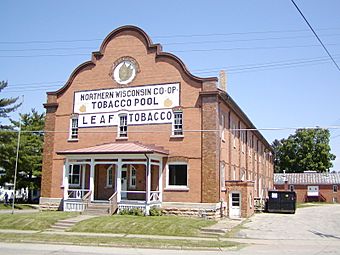Northern Wisconsin Co-op Tobacco Pool Warehouse facts for kids
Quick facts for kids |
|
|
Northern Wisconsin Co-op Tobacco Pool or Bekkedal Leaf Tobacco Warehouse
|
|

Northern Wisconsin Co-op Tobacco Pool Warehouse
|
|
| Location | Viroqua, Wisconsin |
|---|---|
| Built | 1906 |
| Architect | Parkinson and Dockendorff |
| Architectural style | Late Victorian |
| NRHP reference No. | 03001167 |
| Added to NRHP | November 14, 2003 |
The Northern Wisconsin Co-op Tobacco Pool Warehouse is a historic building in Viroqua, Wisconsin. It is also known as the Bekkedal Leaf Tobacco Warehouse. This important building was designed by the architects Parkinson & Dockendorff. It was added to the National Register of Historic Places on November 14, 2003. This means it is a special place recognized for its history.
Contents
History of Tobacco Farming
Tobacco farming started in Wisconsin in the 1830s. Farmers from the eastern United States brought this skill with them. Many Norwegian immigrants also learned to grow tobacco. It became a very profitable cash crop, which means it was grown to be sold for money.
Pioneers moving to Vernon County, Wisconsin brought tobacco farming with them. They grew a lot of tobacco in areas like Coon Valley, Wisconsin and Westby, Wisconsin.
Martin Bekkedal's Warehouse
Martin H. Bekkedal moved to the area in the 1880s. By 1900, he became the biggest tobacco seller in western Wisconsin. He built his large warehouse in 1906. It was made of brick and wood, using a special building style. This warehouse was one of the biggest tobacco storage buildings in the whole state.
Cool Building Features
The warehouse shows how much money could be made from tobacco. It has stylish curved walls at the top, called parapets. These walls on the north and south sides have cool decorations. You can see tobacco leaf designs on them, like special medallions.
Inside the Warehouse
The building had many different rooms for handling tobacco. There were offices for managing the business. A special room had a large scale to weigh the tobacco when it arrived. In the basement, workers sorted and packed the tobacco.
The warehouse also had "sweating" rooms. In these rooms, the temperature could be raised very high, over 115 degrees Fahrenheit. This heat helped to "cure" the tobacco, which is a process that prepares it for use.
The Tobacco Growers' Co-op
In 1921, tobacco prices dropped a lot. This made it hard for farmers to earn money. So, the farmers decided to work together. They formed the nation's first tobacco marketing cooperative. It was called the Northern Wisconsin Tobacco Co-op Pool.
How the Co-op Helped Farmers
The co-op bought the warehouse from Martin Bekkedal. They got 75% of the local tobacco growers to join their group. By working together, they could sell their tobacco directly. This helped them avoid selling to other big companies, called wholesalers. It gave the farmers more control over their own business and how much money they made.
The success of this tobacco co-op inspired other farmers. They started similar cooperatives, like those for dairy farming. Today, the warehouse is owned by a private company.

